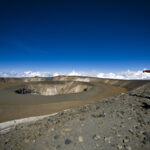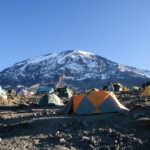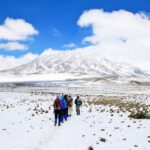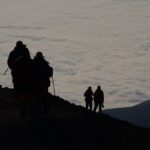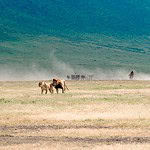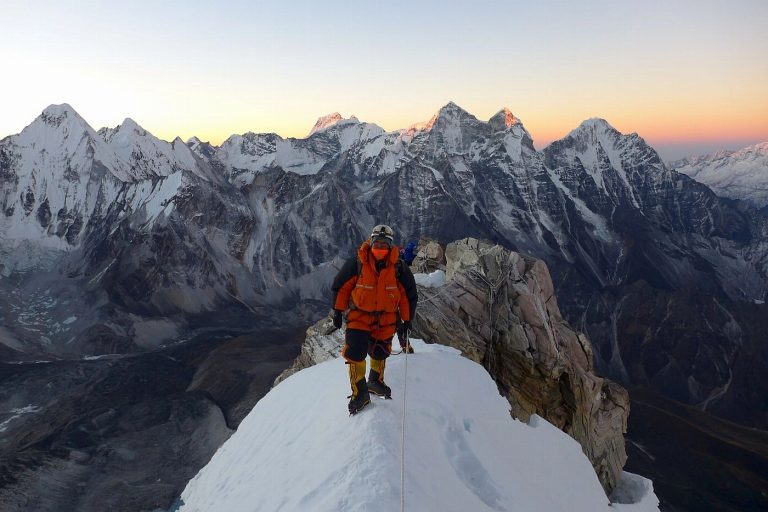Weather in Tanzania
Everything You Need to Know about Snowfall in Tanzania: A Surprising Discovery
Weather in Tanzania : In the heart of East Africa lies a surprising phenomenon that few people are aware of: snowfall in Tanzania. Yes, you read that correctly! While Tanzania is most famous for its vast savannas and iconic wildlife, it also boasts a unique climate that occasionally blesses its highest peaks with a delicate coating of snow. If you thought you needed to travel to the Alps or the Himalayas to experience a winter wonderland, think again.
In this article, we will delve into everything you need to know about snowfall in Tanzania. From the fascinating scientific explanations behind this surprising discovery to the best times and places to witness this rare phenomenon, we have you covered. Whether you’re an outdoor enthusiast seeking a new adventure or simply curious about the enchanting diversity of our planet, this article will quench your thirst for knowledge.
So, grab a warm cup of cocoa, bundle up in a cozy blanket, and prepare to embark on a remarkable journey to the unexpected snowy landscapes of Tanzania.
Historical background of snowfall in Tanzania
While the idea of snowfall in Tanzania may seem like a surprising and unexpected phenomenon, it actually has a long and fascinating history. The first recorded observations of snow on the highest peaks of Tanzania date back to the early 19th century, when European explorers and missionaries began to venture into the interior of the African continent.
One of the earliest known accounts comes from the German explorer Hans Meyer, who in 1889 became the first person to reach the summit of Mount Kilimanjaro, the highest mountain in Africa. In his detailed expedition journals, Meyer described the presence of snow and ice at the summit, marveling at the stark contrast between the tropical climate of the surrounding region and the wintry conditions at the peak.
Over the subsequent decades, more and more reports of snowfall in Tanzania began to emerge, as the country’s rugged, mountainous landscapes became increasingly accessible to researchers and adventurers. In the early 20th century, scientists began to study the phenomenon in greater depth, seeking to understand the unique climatic conditions that could give rise to such an unexpected occurrence.
One of the key figures in this field of research was the renowned climatologist and glaciologist Louis Reynaud, who conducted extensive studies on the glaciers and snowfields of Mount Kilimanjaro in the 1960s and 1970s. Reynaud’s work helped to shed light on the complex interplay of factors that enable snow to form and persist on the upper reaches of Tanzania’s highest peaks, even in a region that is otherwise dominated by a tropical, equatorial climate.
Seasonal Breakdown:
- Dry Season (June – October): This is the best time for wildlife safaris as animals gather around water sources, making sightings frequent and easy.
- Wet Season (November – May): A great time to see migratory birds and experience Tanzania’s stunning greenery, though some roads may be less accessible.
Climatic conditions necessary for snowfall in Tanzania
The presence of snow on the peaks of Tanzania is a testament to the remarkable diversity and complexity of the country’s climate. While the vast majority of Tanzania experiences a warm, humid, and predominantly tropical climate, the highest elevations of the region’s towering mountains create a unique microclimate that can support the formation and persistence of snow.
The key factors that enable snowfall in Tanzania are primarily related to the country’s geography and topography. The most significant of these is the presence of several high-altitude mountain ranges, including the iconic Mount Kilimanjaro, which at 5,895 meters (19,341 feet) above sea level is the highest peak in Africa.
At these lofty elevations, the air temperature is significantly cooler than the surrounding lowlands, often dipping below the freezing point, even during the warmest months of the year. This temperature differential, combined with the high levels of precipitation that are common in the region, creates the ideal conditions for snow to form and accumulate.
Another crucial factor is the influence of the Indian Ocean, which helps to drive the seasonal monsoon patterns that bring substantial rainfall to much of Tanzania. The arrival of these moisture-laden air masses, coupled with the cooling effects of the high-altitude terrain, can result in the formation of snow, particularly during the wettest periods of the year.
Interestingly, the presence of snow on Tanzania’s peaks is not a permanent or year-round phenomenon. The snowfall is highly seasonal, with the majority of it occurring during the country’s two main rainy seasons – the “long rains” from March to May and the “short rains” from October to December. During the drier months, the snow may partially or even completely melt away, depending on the prevailing weather conditions.
Surprising facts about snowfall in Tanzania
While the mere existence of snowfall in Tanzania is already a surprising and unexpected phenomenon, there are several other fascinating facts that further highlight the unique nature of this climatic occurrence.
One of the most remarkable aspects is the sheer scale and extent of the snowfall. Contrary to popular belief, the snow-capped peaks of Tanzania are not limited to a single mountain, such as the iconic Mount Kilimanjaro. In fact, several of the country’s other high-altitude peaks, including Mount Meru, Mount Kenya, and the Rungwe Mountains, also experience periodic snowfall.
The depth and duration of the snow can also be quite impressive, with some reports indicating that the snow can accumulate to depths of several meters, particularly in the sheltered, windswept areas near the summits. The snow may persist for weeks or even months, depending on the timing and intensity of the rainy seasons.
Another surprising fact is the relative rarity of the snowfall. While it does occur with some regularity, the snowfall events in Tanzania are not as frequent or predictable as one might expect. This is due to the delicate balance of climatic factors required to produce the necessary conditions for snow formation, which can be disrupted by larger-scale weather patterns and climate variability.
Interestingly, the snowfall in Tanzania is not a recent phenomenon, but rather has a long history dating back centuries, as evidenced by the accounts of early European explorers and researchers. This suggests that the presence of snow on the country’s peaks is a natural and enduring feature of its unique climate, rather than a recent or temporary occurrence.
Impact of snowfall on wildlife and vegetation in Tanzania
The presence of snow on the highest peaks of Tanzania has a significant impact on the local ecosystem, affecting both the wildlife and vegetation found in these high-altitude environments.
For the diverse array of animal species that call the Tanzanian highlands home, the arrival of snow can present a significant challenge. Many of these animals, such as the iconic African elephant, the elusive leopard, and the majestic African buffalo, are adapted to thrive in the warm, tropical conditions that dominate the majority of the country’s landscapes.
The sudden onset of cold, snowy conditions can disrupt their normal foraging and behavioral patterns, forcing them to adapt or even relocate to more suitable habitats. This can have cascading effects on the delicate balance of the ecosystem, as the absence or displacement of key species can ripple through the food web and affect the overall health and stability of the entire community.
The impact on the vegetation is equally profound. The high-altitude plant life found on the slopes of Tanzania’s snow-capped peaks is uniquely adapted to the harsh, windswept conditions and the relatively short growing season. The arrival of snow can bury these specialized plants, disrupting their access to sunlight and essential nutrients, and potentially leading to die-off or reduced productivity.
Moreover, the melting of the snow can also have significant implications for the local hydrology, as the water released from the snowpack can contribute to the formation of streams, rivers, and other critical water sources that sustain the diverse ecosystems found throughout the region. The timing and volume of this meltwater can have far-reaching consequences for both the natural world and the human communities that rely on these water resources.
Challenges and risks associated with snowfall in Tanzania
While the presence of snow on Tanzania’s highest peaks may seem like a delightful and enchanting phenomenon, it also presents a range of challenges and risks that must be carefully navigated.
One of the primary concerns is the potential impact of snowfall on the region’s infrastructure and transportation networks. The accumulation of snow and ice on roads and trails can make travel to and from the affected areas extremely hazardous, potentially isolating remote communities and disrupting the flow of essential goods and services.
This can be particularly problematic in areas where the infrastructure is already limited or poorly maintained, as the additional strain of heavy snowfall can quickly overwhelm the available resources and lead to further disruptions. Emergency response and rescue operations may also be hampered by the treacherous conditions, putting the safety and well-being of both residents and visitors at risk.
Another significant challenge is the potential impact of snowfall on the local economy, particularly in regions where tourism is a crucial source of income. The unpredictable nature of the snowfall events and the logistical challenges they present can make it difficult for tourism operators to plan and prepare effectively, leading to canceled or disrupted trips and a loss of revenue.
Furthermore, the presence of snow on Tanzania’s peaks can also pose a threat to the delicate ecosystem, as the disruption to the natural balance of the region’s flora and fauna can have cascading effects that are difficult to predict or mitigate. The melting of the snow can also contribute to the risk of landslides, flooding, and other natural disasters, which can further exacerbate the challenges faced by local communities.
Snowfall tourism in Tanzania
Despite the challenges and risks associated with snowfall in Tanzania, the phenomenon has also given rise to a unique and growing tourism industry that caters to adventurous travelers seeking to experience this unexpected natural wonder.
The opportunity to witness snow in an otherwise tropical African setting has captured the imagination of outdoor enthusiasts, nature lovers, and those seeking a truly unique and unforgettable travel experience. As a result, a number of specialized tour operators and adventure companies have emerged, offering guided expeditions and trekking experiences that allow visitors to explore the snow-capped peaks of Tanzania.
One of the most popular destinations for snowfall tourism is, of course, the iconic Mount Kilimanjaro. This majestic mountain, which is the tallest freestanding mountain in the world, attracts thousands of climbers each year, many of whom hope to catch a glimpse of the snow and ice that adorns its summit during the rainy seasons.
Other popular snowfall destinations in Tanzania include Mount Meru, the Rungwe Mountains, and the Ngorongoro Crater, all of which offer the chance to witness the enchanting sight of snow in the midst of a tropical landscape. These destinations not only provide opportunities for hiking and mountaineering but also offer the chance to explore the unique flora and fauna that thrive in the high-altitude environments.
The growth of snowfall tourism in Tanzania has also had a positive impact on the local economy, providing employment opportunities for guides, porters, and other support staff, as well as generating revenue for the communities that host these activities. However, it is crucial that this industry be developed and managed in a sustainable manner, to ensure that the delicate balance of the region’s ecosystems is not disrupted by the influx of visitors.
Conservation efforts to protect snowfall in Tanzania
As the phenomenon of snowfall in Tanzania has gained greater recognition and attention, both within the country and on the global stage, there has been a growing emphasis on the importance of protecting and preserving this unique natural resource.
One of the key initiatives in this regard has been the establishment of various protected areas and conservation zones that encompass the high-altitude regions where the snow-capped peaks are located. These include national parks, such as Kilimanjaro National Park and Arusha National Park, as well as other designated conservation areas that are designed to safeguard the fragile ecosystems found at these elevations.
Within these protected areas, strict regulations and management practices are in place to limit human activity and disturbance, ensuring that the delicate balance of the environment is maintained. This includes measures to control the impact of tourism, such as limiting the number of visitors, enforcing strict guidelines for trekking and mountaineering activities, and promoting the use of sustainable practices and technologies.
In addition to these on-the-ground conservation efforts, there has also been a concerted push to increase scientific research and monitoring of the snowfall phenomenon in Tanzania. This has involved the deployment of advanced weather monitoring equipment, the establishment of long-term glacial and snow cover studies, and the collaboration of researchers from around the world to better understand the complex interplay of climatic factors that give rise to this unique occurrence.
These conservation initiatives are not only crucial for protecting the snowfall itself but also for safeguarding the broader ecosystem, which is home to a diverse array of plant and animal species that are adapted to the high-altitude environments. By preserving the integrity of these habitats, the hope is that the snowfall in Tanzania will continue to be a source of wonder and fascination for generations to come.
Famous snowfall destinations in Tanzania
While the phenomenon of snowfall in Tanzania may be relatively unknown to the broader public, there are several destinations within the country that have gained recognition and popularity among those seeking to witness this unique natural wonder.
One of the most iconic and well-known of these destinations is, of course, Mount Kilimanjaro. As the highest peak in Africa, Kilimanjaro is a magnet for adventurous travelers, many of whom embark on challenging treks to the summit in the hopes of catching a glimpse of the snow-capped peak. During the rainy seasons, the mountain’s upper slopes can be blanketed in a delicate layer of white, creating a breathtaking contrast against the lush, tropical landscapes below.
Another famous snowfall destination in Tanzania is Mount Meru, the second-highest mountain in the country. While not as tall as Kilimanjaro, Mount Meru nonetheless offers stunning views of the surrounding region, and its high-altitude slopes can also experience periodic snowfall, particularly during the wettest times of the year.
The Rungwe Mountains, located in the southwestern corner of Tanzania, are another notable destination for those seeking to witness snowfall. This rugged, volcanic range is home to several peaks that can receive a dusting of snow, and the region’s remote and relatively undeveloped nature adds to the sense of adventure and exploration.
Finally, the Ngorongoro Crater, a UNESCO World Heritage Site and one of Tanzania’s most iconic natural wonders, can also experience occasional snowfall on its highest rim. While the crater itself is renowned for its diverse wildlife and stunning landscapes, the presence of snow on the rim adds an extra layer of enchantment to this already breathtaking destination.
Conclusion: The unique beauty of snowfall in Tanzania
In a world that is often divided into the familiar dichotomies of the tropics and the temperate zones, the presence of snowfall in Tanzania serves as a powerful reminder of the remarkable diversity and complexity of our planet’s climates and ecosystems.
This unexpected phenomenon, which blesses the highest peaks of the East African nation with a delicate coating of white, is a testament to the resilience and adaptability of the natural world, as well as the ongoing process of discovery and exploration that continues to reveal the hidden wonders of our shared home.
Whether you are a seasoned adventurer seeking a new and unique challenge, a nature enthusiast captivated by the enchanting diversity of our planet, or simply a curious individual eager to expand your understanding of the world around you, the snowfall of Tanzania offers a truly remarkable and unforgettable experience.
From the towering, snow-capped majesty of Mount Kilimanjaro to the remote and rugged landscapes of the Rungwe Mountains, the snowfall of Tanzania invites us to step outside the bounds of our preconceptions and immerse ourselves in the breathtaking beauty and wonder of this unexpected natural phenomenon.
As we continue to explore and appreciate the unique and surprising aspects of our world, may the snowfall of Tanzania serve as a reminder of the boundless potential for discovery and the enduring capacity of our planet to surprise and delight us, even in the most unexpected of places.

